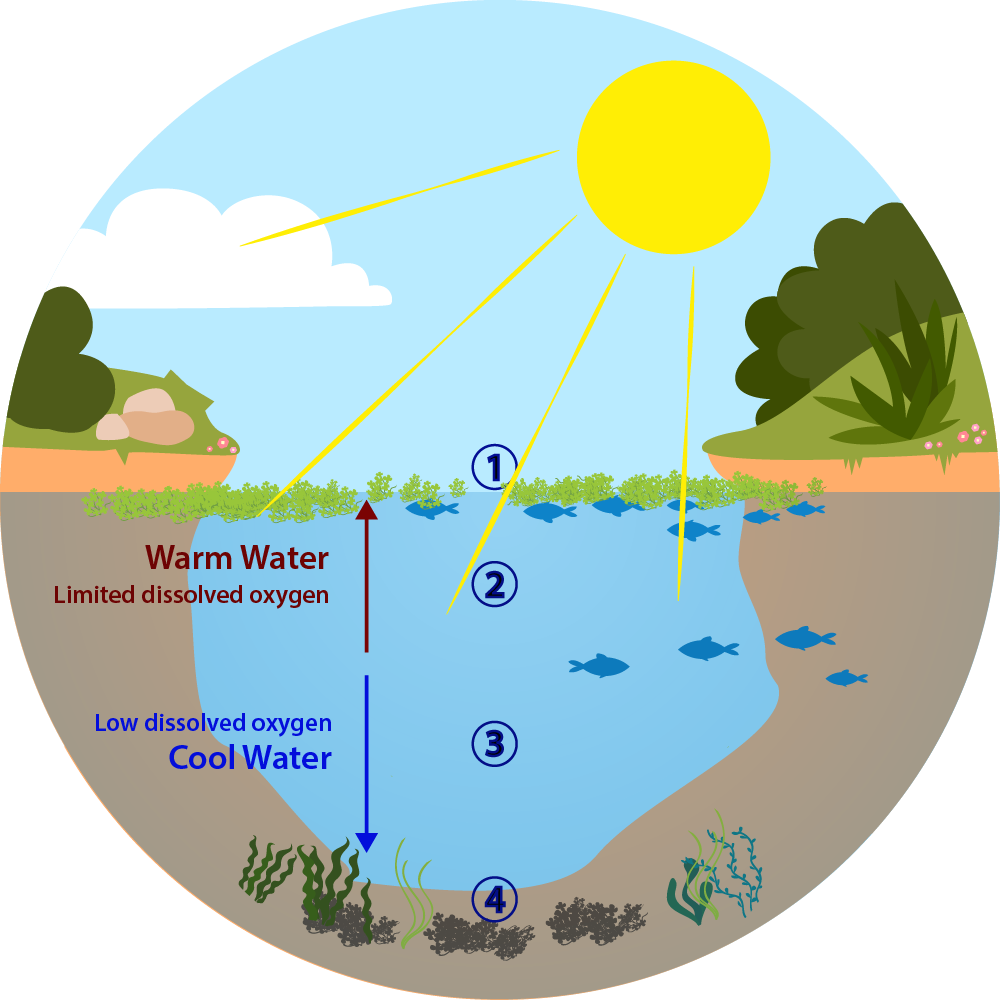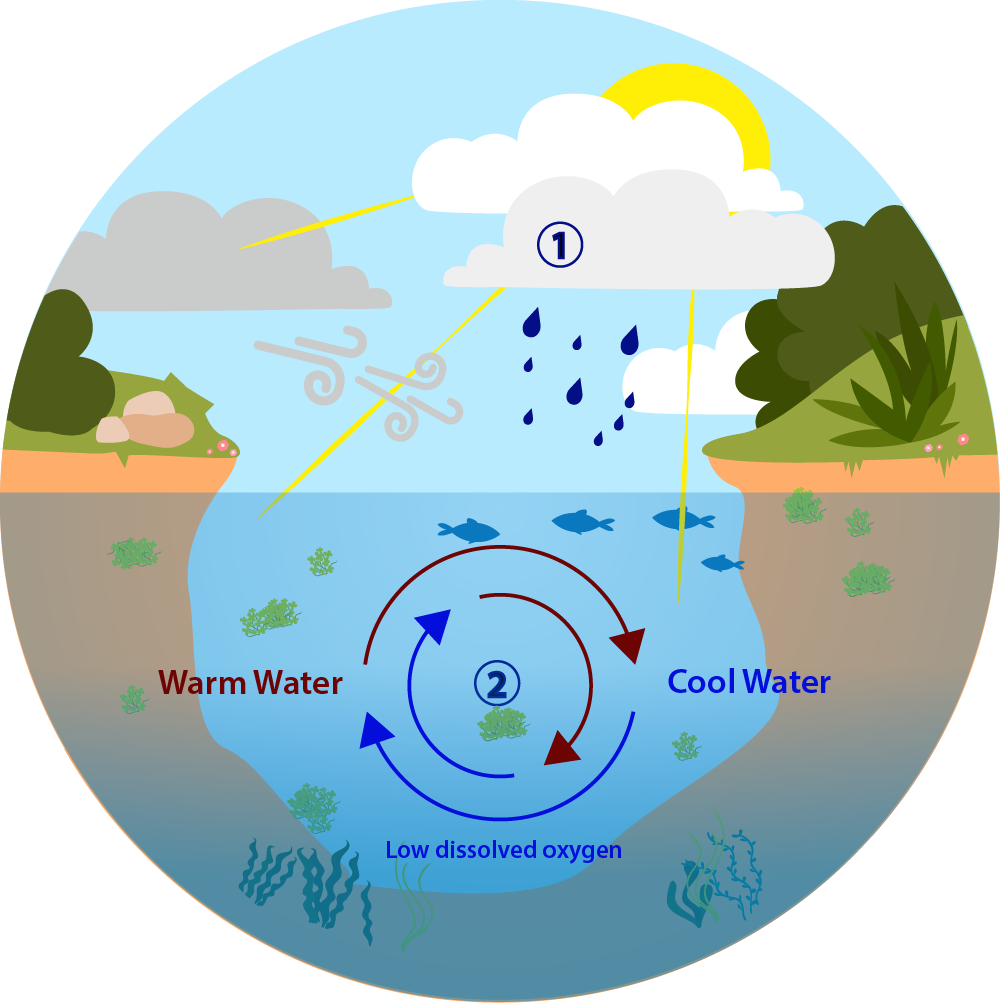
Fish kills in NSW 2020-2021
Please report any fish death incidents or observations to the Fishers Watch Phoneline on 1800 043 536
What are fish kills?
Fish kills are defined as a sudden mass mortality of wild fish.
Fish kills can occur at any time although data indicates fish kills are more likely to occur in summer or following sudden changes in temperature.
Recent reports of fish kills are included in the table below and we will update the table as we receive reports.
Some of the key causes of fish kills are outlined in the information below.
Blackwater
Blackwater occurs naturally over time when leaf litter and woody debris build up on the floodplain and then get washed into the river system during a flood. It’s an important part of the aquatic food web as it provides food for insects which feed fish, frogs and other aquatic wildlife.
When there is a prolonged dry period, the leaf litter and organic matter on the floodplain builds up until the next flood event. This can result in a significant amount of organic matter returning to the river with any big flushes of water after prolonged drought, making blackwater events more likely.
Hypoxic blackwater
When there is a lot of organic material washed into the river, its rapid decay can consume dissolved oxygen from the water. If dissolved oxygen drops to very low levels, this can cause ‘hypoxic’ water which can be stressful for native fish and can lead to fish kills.
More information on blackwater can be found on the MDBA website and in this factsheet by DPIE Environment, Energy and Science (NSW DPIE EES).
To notify the department of potential blackwater events email waterqualitydata@industry.nsw.gov.au or to report a fish kill, contact the Fishers Watch Phoneline on 1800 043 536.
Bushfire impacts on native fish
Find information on the impacts of bushfires on native fish.
Stratification?
Stratification is when the surface of the water heats up more than the deeper water. That warmer layer tends to be warm and well-oxygenated compared to the deeper water that is colder and oxygen-depleted.
Thermal stratification
Key
- Blue Green Algal Bloom
Algal flourish in warm and still conditions, particularly in the absence of high flow - Surface Water Layer
Warm, high nutrient load from run off.
Dissolved oxygen by day, depletion overnight
Limited fish habitat - Deep Water Layer
Cooler, low light penetration, low dissolved oxygen (hypoxia), Poor fish habitat - Decomposition of organic matter
Depletes dissolved oxygen
De-stratification ("Turn over")
Key
- Sudden weather events or small increases in flow
Can mix the warmer surface water and cooler deep water – essentially breaking down the temperature stratification - These changes can mix the warmer surface water with cooler deep water
Algal blooms may also be disrupted, potentially increasing decomposition (and further depleting oxygen). This means even at the surface dissolved oxygen levels can become critical, killing fish.
Simple things you can do
- Be on the lookout for any changes in water quality - i.e. changes to the colour or odour of your local waterway and report them to us via the Fishers Watch Phoneline on 1800 043 536.
- Contact us on the phoneline if you observe any dead fish or fish starting to gasp at the water surfaces.
Investigating and reporting
Recent fish death events
Updated: 2 March 2021 (7pm)
Below are the fish kills that were investigated and confirmed by NSW DPI Fisheries.
- More information on the 2018/19 fish kill events.
- More information on the 2019/20 fish kill events.
1 July 2020 - 30 June 2021
Location and date kill observed | Cause and extent |
|---|---|
Murray Darling catchments in NSW | |
| Murray River, Downstream of Hume Dam (19 February) | Report of 2 dead fish received. Fisheries Officers attended and witnessed Murray Crayfish walking out of the water. Suspected cause was bushfire runoff entering the water immediately below Hume Dam, resulting in a drop in dissolved oxygen levels. 38 Murray Crayfish were rescued and relocated to Charles Sturt University by DPI Fisheries staff. |
| Dairy Creek, Corowa (28 January) | Report of between 10-20 dead fish. Species affected were Murray Cod and Golden Perch. Suspected cause was be a reduction in dissolved oxygen in the lagoon following extended hot weather and low water levels within the lagoon. |
| Gwydir River, Gwydir Valley (19 December) | Report of approximately 100 dead fish within Tareelaroi Weir pool. The main species affected were Bony Herring along with minor numbers of Murray Cod. Heavy rainfall in the upper catchment in preceding days resulted in a large increase in river flow and associated organic material entering waterways leading to deoxygenation and subsequent fish deaths. |
Peel River, Tamworth (7 December) | Report of 10 to 20 dead fish including European Carp and Murray Cod. Cause was episodic rainfall event the preceding weekend that caused short and sharp flow in the river. This can cause a rapid reduction in dissolved oxygen levels due to large volumes of organic material entering the river system. |
| Carcoar Dam (19 September) | Report of ten dead fish around the dam. Species affected were Murray Cod and Golden Perch. Suspected cause was episodic rainfall event the preceding days that caused short and sharp flow in the river. This can cause a rapid reduction in dissolved oxygen levels due to large volumes of organic material entering the river system. |
| Lake Mulwala, Murray River (30 August) | Report of thousands of dead shrimp and yabbies. Cause could not be determined. |
Coastal catchments in NSW | |
| Clybucca Creek, Macleay River (22 February) | Report of 10-100 dead fish. Main species affected were Bream and Flathead. Suspected cause was critically low dissolved oxygen levels due to local flooding of coastal floodplains. |
| Korrongulla Swamp, Primbee (2 February) | Report of 200 dead fish. Main species affected was Carp. Suspected cause was critically low dissolved oxygen levels due to an algal bloom of Duckweed (Lemnoideae). |
| Ephemeral Tributary of Whitemans Creek, Near Grafton (12 January) | Report of 20 dead fish. Species affected were Eels and Bony Bream. Suspected cause was critically low dissolved oxygen due to recent inflows that washed large volumes of organic material entering the river system. |
| Seven Mile, Illawarra (31 December) | Report of a large dead sting ray with five babies. Cause was undetermined. |
| Potato Creek (27 December) | Report of hundreds of dead fish. Main species affected was Mullet. Suspected cause was the opening of the creek causing reduced water levels and water quality. |
| Clybucca Creek, Macleay Valley (21-24 December) | Report of thousands of dead fish. Species affected included Bully Mullet, Herring, Dusky Flat head, Bream, Whiting, sole, Garfish,Mud Crabs, and benthic worms. Suspected cause was critically low dissolved oxygen levels due to hypoxic blackwater following recent heavy rainfall and localised flooding. |
| Rocky Mouth Creek, Richmond River (21 December) | Report of less than 20 dead fish including Mullet and Bream. Suspected cause was a drop in dissolved oxygen following recent rainfall and localised flooding |
| Alumny Creek (21 December) | Report of hundreds of dead fish. Species affected included Catfish, Mullet and Eels. Suspected cause was episodic rainfall event the preceding days that caused short and sharp flow in the river. This can cause a rapid reduction in dissolved oxygen levels due to large volumes of organic material entering the river system. |
| Lavertys Gap Weir, Wilsons Creek (8 December) | Report of less than 10 dead fish. Species affected was Eastern Freshwater Cod. Suspected cause was low dissolved oxygen due to lack of inflows from the upstream weir. |
| Bicentennial Fields, Rockdale (16 November) | Report of less than 10 dead fish. Species affected was European Carp. Cause was undetermined. |
| Lennox Head Boardwalk, Dress Circle Drive (14 November) | Report of thousands of dead Blue Pilchards. Likely cause was that they were chased into the lagoon pools by predators during high tide and were then unable to exist when the tide receded. |
| Corunna Lake (22 October) | Report of thousands of dead sea slugs. Cause was undetermined. |
| Daveys Island, Terranora Creek, Tweed Heads (16 October) | Report of 30 to 40 dead Yellowfin Bream, reported to the EPA. Cause was undetermined. |
| Lake Cathie (12 October) | Report of 10 to 100 dead fish. Main species affected included Sea Mullet. Suspected cause was low dissolved oxygen and low pH. |
| Private Dam, Kurmond (30 September | Report of 10 to 100 dead fish including Silver Perch and Catfish. Cause was undetermined. |
| Bega River, (18 September) | Report of hundreds of dead fish. Species affected included Australian Bass, Sand Whiting and Mullet. Suspected cause was episodic rainfall event the preceding weekend that caused short and sharp flow in the river. This can cause a rapid reduction in dissolved oxygen levels due to large volumes of organic material entering the river system. |
| Pateron River, Port Stephens (30 August) | Report of approximately 30-40 dead fish. Cause was a rapid reduction in dissolved oxygen levels due to episodic rainfall in the days prior. |
| Flat Rock Dam, Nowra (27 August) | Report of dead Bass at Flat Rock Dam. Cause could not be determined. |
| Sandringham Baths, Sandringham (25 August) | Report of approximately 10 dead Mulloway found in a swimming net. Cause could not be determined. |
| Batemans Bay, Shoreline (11 August) | Report of thousands of dead fish including Abalone, Marine Snails, Groper and Cuttlefish. Suspected cause was freshwater turnover. |
| Lennox Head (22 July) | Report of thousands of dead Australian Anchovy near the boat ramp. Cause could not be determined. |



